- Home
- Salman Rushdie
Languages of Truth Page 2
Languages of Truth Read online
Page 2
In Egypt in May 2010, just seven months before the revolt against President Hosni Mubarak, a group of Islamist lawyers got wind of a new edition of Alf Laylah wa Laylah (the book’s original Arabic title) and brought an action demanding that the edition be withdrawn and the book banned, because it was “a call to vice and sin” that contained several references to sex. Fortunately, they did not succeed, and then larger matters began to preoccupy Egyptian minds. But the fact is, they had a point. There are indeed in that book several references to sex, and the characters seem much more preoccupied with having sex than being devout, which could indeed be, as the lawyers argued, a call to vice, if that’s the deformed puritanical way you see the world. To my mind, this call is an excellent thing and well worth responding to, but you can see how people who dislike music, jokes, and pleasure would be upset by it. It is rather wonderful that this ancient text, this wonderful group of wonder tales, retains the power to upset the world’s fanatics more than twelve hundred years after the stories first came into the world.
The book that we now usually call The Arabian Nights didn’t originate in the Arab world. Its probable origin is Indian; Indian story compendiums too have a fondness for frame stories, for Russian-doll-style stories within stories, and for animal fables. Somewhere around the eighth century, these stories found their way into Persian, and according to surviving scraps of information, the collection was known as Hazar Afsaneh, “a thousand stories.” There’s a tenth-century document from Baghdad that describes the Hazar Afsaneh and mentions its frame story, about a wicked king who kills a concubine every night until one of these doomed wives manages to stave off her execution by telling him stories. This is where we first see the name “Scheherazade.” Sadly, of the Hazar Afsaneh itself not a single copy survives. This book is the great “missing link” of world literature, the fabled volume through which the wonder tales of India traveled west to encounter, eventually, the Arabic language and to turn into The Thousand Nights and One Night, a book with many versions and no agreed canonical form, and then to move farther west, first into French, in the eighteenth-century version by Antoine Galland, who added a number of stories not included in the Arabic, such as the tales of “Aladdin and the Wonderful Lamp” and “Ali Baba and the Forty Thieves.” And from French the stories made it into English, and from English they journeyed to Hollywood, which is a language of its own, and then it’s all flying carpets and Robin Williams as The Genie. (It’s worth noting, by the way, that there are no flying carpets in The Arabian Nights. There are flying carpets elsewhere in the Eastern tradition. For example, there’s a legend that King Solomon possessed one that could change its size and become big enough to transport an army: the world’s first air force. But in The Arabian Nights, all carpets remain passive and inert.)
This great migration of narrative has inspired much of the world’s literature, all the way down to the magic realism of the South American fabulists, so that when I, in my turn, used some of those devices, I had the feeling of closing a circle and bringing that story tradition all the way back home to the country in which it began. But I mourn the loss of the Hazar Afsaneh, which would, if rediscovered, complete the story of the stories, and what a find that would be. Perhaps it would solve a mystery at the heart of the frame story, or rather at the very end of it, and answer a question I’ve been asking myself for some years: Did Scheherazade and her sister, Dunyazad, finally, after one thousand nights and one night and more, become murderers and kill their bloodthirsty husbands?
It was, I confess, the bloody aspect of the frame story that first attracted me to The Arabian Nights. Let’s make a small calculation.
How many women did they actually kill, this king, this Shahryar, the Sassanid monarch of “the island or peninsula of India and China,” and his brother, Shah Zaman, sovereign ruler over barbarian Samarkand? It began, or so the story goes, when Shah Zaman found his wife in the arms of a palace cook, whose chief characteristics were that he was (a) black, (b) huge, and (c) covered in kitchen grease. In spite of, or perhaps because of, these characteristics, the queen of Samarkand was obviously having far too much fun, so Shah Zaman chopped her and her lover into several pieces, left them there on the bed of their delight, and headed for his brother’s home, where, not long afterward, he chanced to espy his sister-in-law, Shahryar’s queen, in a garden, by a fountain, in the company of ten ladies-in-waiting and ten white slaves. The ten and ten were busy gratifying one another; the queen, however, summoned her own lover down from a convenient tree. This hideous fellow was, yes, (a) black, (b) huge, and (c) slobbering! What fun they had, the ten and ten and the queen and her “blackamoor”! Ah, the malice and treachery of womankind, and the unaccountable attraction of huge, ugly, dripping black men! Shah Zaman told his brother what he had seen, whereupon the ladies-in-waiting, the white slaves, and the queen all met their fates, personally executed by Shahryar’s chief minister, his vizier (or wazir). The “slobbering” black lover of Shahryar’s late queen escaped, or so it seems; how else to explain his absence from the list of the dead?
King Shahryar and King Shah Zaman duly took their revenge on faithless womankind. For three years, they each married, deflowered, and then ordered the execution of a fresh virgin every night. It is not clear how Shah Zaman in Samarkand went about his gory business, but of Shahryar’s methods there are things that can be told. It is known, for instance, that the vizier—Scheherazade’s father, Shahryar’s wise prime minister—was obliged to carry out the executions himself. All those beautiful young bodies, decapitated; all those tumbling heads and bloody, spurting necks. The vizier was a cultured gentleman, not only a man of power but also a person of discernment, even of delicate sensibilities—he must have been, must he not, to have raised such a paragon, such a wondrously gifted, multiply accomplished, heroically courageous, selfless daughter as Scheherazade? And Dunyazad too; let’s not forget the kid sister, Dunyazad. Another good, smart, decent girl. What would it do to the soul of the father of such fine girls to be forced to execute young women by the hundreds, to slit girls’ throats and see their lifeblood flow? What secret fury might have burgeoned in his subtle breast? We are not told. We do know, however, that Shahryar’s subjects began to resent him mightily and to flee his capital city with their womenfolk, so that after three years there were no virgins to be found in town.
No virgins except Scheherazade and Dunyazad.
Three years already: one thousand and ninety-five nights, one thousand and ninety-five dead queens for Shahryar, one thousand and ninety-five more for Shah Zaman, or one thousand and ninety-six each if a leap year was involved. Let’s err on the low side. One thousand and ninety-five each let it be. And let us not forget the original twenty-three. By the time Scheherazade entered the story, marrying King Shahryar and ordering her sister, Dunyazad, to sit at the foot of the marital bed and to ask, after Scheherazade’s deflowering was complete, to be told a bedtime story…By this time, Shahryar and Shah Zaman were already responsible for two thousand, two hundred and thirteen deaths. Only eleven of the dead were men.
Shahryar, upon marrying Scheherazade and being captivated by her tales, stopped killing women. Shah Zaman, untamed by literature, went right on with his vengeful work, slaughtering each morning the virgin he’d ravished the night before, demonstrating to the female sex the power of men over women, the ability of men to separate fornication from love, and the inevitable union, as far as women were concerned, of sexuality and death. In Samarkand the carnage continued for at least another one thousand nights and one night, because it was only at the conclusion of the entire cycle of Scheherazade’s tales—when that greatest of storytellers begged to be spared, not in recognition of her genius but for the sake of the three sons she had given Shahryar during the fabled years, and when Shahryar confessed his love for her, the last of his one thousand and ninety-seven wives, and gave up all pretense of murderous intent—that Shah Zaman’s project also ended; cl
eansed at last of bloodlust, he asked for, and received, sweet Dunyazad’s hand in marriage.
The minimum total number of the dead by this time was, by my calculation, three thousand, two hundred and fourteen. Only eleven of the dead were men.
Consider Scheherazade, whose name meant “city-born” and who was without a doubt a big-city girl, crafty, wisecracking, by turns sentimental and cynical, as contemporary a metropolitan narrator as one could wish to meet. Scheherazade, who snared the prince in her never-ending story. Scheherazade, telling stories to save her life, setting fiction against death, a Statue of Liberty built not of metal but of words. Scheherazade, who insisted, against her father’s will, on taking her place in the procession into the king’s deadly boudoir. Scheherazade, who set herself the heroic task of saving her sisters by taming the king. Who had faith, who must have had faith, in the man beneath the murderous monster and in her own ability to restore him to his true humanity, by telling him stories.
What a woman! It’s easy to understand how and why King Shahryar fell in love with her. For certainly he did fall, becoming the father of her children and understanding, as the nights progressed, that his threat of execution had become empty, that he could no longer ask his vizier, her father, to carry it out. His savagery was blunted by the genius of the woman who, for a thousand nights and one night, risked her life to save the lives of others, who trusted her imagination to stand against brutality and overcome it not by force but, amazingly, by civilizing it.
Lucky king! But (this is the greatest unanswered question of The Arabian Nights) why on earth did she fall in love with him? And why did Dunyazad, the younger sister who sat at the foot of the marital bed for one thousand nights and one night, watching her sister being fucked by the murderous king and listening to her stories—Dunyazad, the eternal listener, but also voyeur—why did she agree to marry Shah Zaman, a man even deeper in blood than his story-charmed brother?
How can we understand these women? There is a silence in the tale that cries out to be spoken of. This much we are told: After the stories were over, Shah Zaman and Dunyazad were married, but Scheherazade made one condition—that Shah Zaman leave his kingdom and come to live with his brother, so that the sisters might not be parted. This Shah Zaman gladly did, and Shahryar appointed to rule over Samarkand in his brother’s stead that same vizier who was now also his father-in-law. When the vizier arrived in Samarkand, he was greeted by the townspeople very joyfully, and all the local grandees prayed that he might reign over them for a long time. Which he did.
My question is this, as I interrogate the ancient story: Was there a conspiracy between the daughter and the father? Is it possible that Scheherazade and the vizier had hatched a secret plan? For, thanks to Scheherazade’s strategy, Shah Zaman was no longer king in Samarkand. Thanks to Scheherazade’s strategy, her father was no longer a courtier and unwilling executioner but a king in his own right, a well-beloved king, what was more, a wise man, a man of peace, succeeding a bloody ogre. And then, without explanation, Death came, simultaneously, for Shahryar and Shah Zaman. Death, the “Destroyer of Delights and the Severer of Societies, the Desolator of Dwelling Places and the Garnerer of Graveyards,” came for them, and their palaces lay in ruins, and they were replaced by a wise ruler, whose name we are not told.
But how and why did the Destroyer of Delights arrive? How was it that both brothers died simultaneously, as the text clearly implies, and why did their palaces afterward lie in ruins? And who was their successor, the Unnamed and Wise?
We are not told. But imagine, once again, the vizier filling up with fury for many years as he was forced to spill all that innocent blood. Imagine the years of the vizier’s fear, the one thousand and one nights of fear, while his daughters, flesh of his flesh, blood of his blood, were hidden in Shahryar’s bedroom, their fate hanging by a story’s thread.
How long will a man wait for his revenge? Will he wait longer than one thousand nights and one night?
This is my theory: that the vizier, now ruler of Samarkand, was the wise king who came home to rule Shahryar’s kingdom. And the kings died simultaneously either at their wives’ hands or at the vizier’s. It’s just a theory. Maybe the answer lies in the great lost book. Maybe it doesn’t. We can only…wonder.
At any rate, the final count of the dead was three thousand, two hundred and sixteen. Thirteen of the dead were men.
* * *
—
When I finished my memoir, Joseph Anton, I felt a deep hunger for fiction. And not just any old fiction, but fiction as wildly fantastic as the memoir had been determinedly realistic. My mood swung from one end of the literary pendulum’s arc to the other extreme. And I began to remember the stories that had made me fall in love with literature in the first place, tales full of beautiful impossibility, which were not true but by being not true told the truth, often more beautifully and memorably than stories that relied on being true. Those stories didn’t have to happen once upon a time either. They could happen right now. Yesterday, today, or the day after tomorrow.
One of these wonder tales is from the Kashmiri Sanskrit compendium, the Katha Sarit Sagara or “Ocean of the Streams of Story,” whose title inspired my children’s book Haroun and the Sea of Stories. I confess that I stole this story and put it in a novel. It goes something like this:
“Once upon a time in a faraway place, a merchant was owed money by a local nobleman, really quite a lot of money, and then unexpectedly the nobleman died and the merchant thought, This is bad, I’m not going to get paid. But a god had given him the gift of transmigration—this was in a part of the world in which there were many gods, not just one—so the merchant had the idea of migrating his spirit into the dead lord’s body so that the dead man could get up from his deathbed and pay him what he owed. The merchant left his body in a safe place, or so he thought, and his spirit jumped into the dead man’s skin, but when he was walking the dead man’s body to the bank, he had to pass through the fish market, and a large dead codfish lying on a slab saw him go past and started to laugh. When people heard the dead fish laughing, they knew there was something fishy about the walking dead man and attacked him for being possessed by a demon. The dead nobleman’s body quickly became uninhabitable, and the merchant’s spirit had to abandon it and make its way back to its own discarded shell. But some other people had found the merchant’s empty body and, thinking it the body of a dead man, had set it on fire according to the customs of that part of the world. So now the merchant had no body and had not been paid what he was owed, and his spirit is probably still wandering somewhere in the market. Or maybe he ended up migrating into a dead fish and swam away into the ocean of the streams of story. And the moral of the story is, don’t push your fucking luck.”
Animal fables—including talking-dead-fish fables—have been among the most enduring tales in the Eastern canon, and the best of them, unlike, say, the fables of Aesop, are amoral. They don’t seek to preach about humility or modesty or moderation or honesty or abstinence. They do not guarantee the triumph of virtue. As a result, they seem remarkably modern. The bad guys sometimes win.
The collection known in India as the Panchatantra features a pair of talking jackals: Karataka, the good or better guy of the two, and Damanaka, the wicked schemer. At the book’s outset they are in the service of the lion king, but Damanaka doesn’t like the lion’s friendship with another courtier, a bull, and tricks the lion into believing the bull to be an enemy. The lion murders the innocent animal while the jackals watch.
The end.
In the tales of Karataka and Damanaka we also read about a war between crows and owls, in which one crow pretends to be a traitor and joins the owls to discover the location of the cave where they live. Then the crows set fires at all the entrances to the cave, and the owls all suffocate to death.
The end.
In a third story a man leav
es his child in the care of his friend, a mongoose, and when he returns he sees blood on the mongoose’s mouth and kills it, believing it has attacked his child. Then he discovers the mongoose has actually killed a snake and saved his child. But by now the mongoose is unfortunately deceased.
The end.
Many of Aesop’s little morality tales about the victory of dogged slowness (the tortoise) over arrogant speed (the hare), or the foolishness of crying “wolf” when there is no wolf, or of killing the goose that laid the golden eggs, seem positively soppy when compared to this Quentin Tarantino savagery. So much for the cliché of the peaceful, mystical East.
As a migrant myself, I have always been fascinated by the migration of stories, and these jackal tales traveled almost as far as the Arabian Nights narratives, ending up in both Arabic and Persian versions, in which the jackals’ names have mutated into Kalila and Dimna. They also ended up in Hebrew and Latin and eventually, as The Fables of Bidpai, in English and French. Unlike the Arabian Nights stories, however, they have faded from modern readers’ consciousness, perhaps because their insufficient attention to happy endings made them unattractive to the Walt Disney Company.
Yet their power endures; and it does so, I believe, because for all their cargo of monsters and magic, these stories are entirely truthful about human nature (even when in the form of anthropomorphic animals). All human life is here, brave and cowardly, honorable and dishonorable, straight-talking and conniving, and the stories ask the greatest and most enduring question of literature: How do ordinary people respond to the arrival in their lives of the extraordinary? And they answer: Sometimes we don’t do so well, but at other times we find resources within ourselves we did not know we possessed, and so we rise to the challenge, we overcome the monster, Beowulf kills Grendel and Grendel’s more fearsome mother as well, Red Riding Hood kills the wolf, or Beauty finds the love within the beast and then he is beastly no more. And that is ordinary magic, human magic, the true wonder of the wonder tale.

 Shame
Shame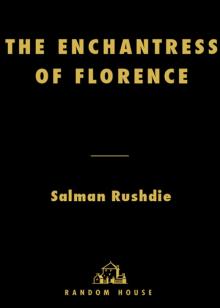 The Enchantress of Florence
The Enchantress of Florence Imaginary Homelands: Essays and Criticism 1981-1991
Imaginary Homelands: Essays and Criticism 1981-1991 Joseph Anton: A Memoir
Joseph Anton: A Memoir Midnight's Children
Midnight's Children East, West: Stories
East, West: Stories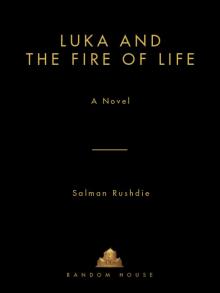 Luka and the Fire of Life
Luka and the Fire of Life Fury Fury Fury
Fury Fury Fury Haroun and the Sea of Stories
Haroun and the Sea of Stories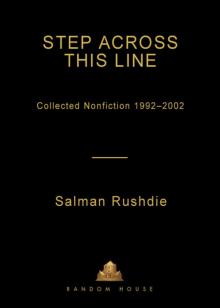 Step Across This Line: Collected Nonfiction 1992-2002
Step Across This Line: Collected Nonfiction 1992-2002 The Satanic Verses
The Satanic Verses The Moor's Last Sigh
The Moor's Last Sigh The Prophet's Hair
The Prophet's Hair The Ground Beneath Her Feet
The Ground Beneath Her Feet Two Years Eight Months and Twenty-Eight Nights
Two Years Eight Months and Twenty-Eight Nights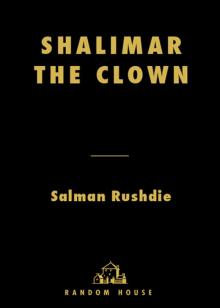 Shalimar the Clown
Shalimar the Clown Grimus
Grimus The Duniazát
The Duniazát Fury
Fury Quichotte
Quichotte The Jaguar Smile
The Jaguar Smile Joseph Anton
Joseph Anton Joseph Anton: A Memoir: A Memoir
Joseph Anton: A Memoir: A Memoir Imaginary Homelands
Imaginary Homelands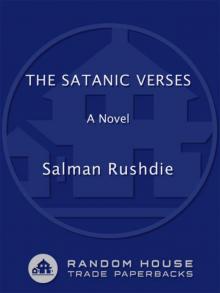 The Satanic Verses: A Novel
The Satanic Verses: A Novel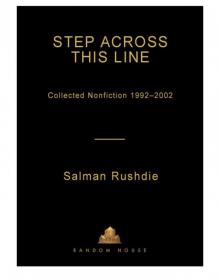 Step Across This Line
Step Across This Line East, West
East, West